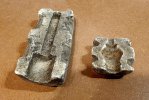canonvela
proper brummie kid
When digging out the floor of our house to lay a new one we found that it had been bedded on what can be best described as historic industrial waste. In amongst the stones and rubble were pieces of mother of pearl that had holes where buttons were cut from them, and a lot of plaster moulds. The moulds came singly and in matched pairs and looked to have been used for casting knobs and other metal items.
These moulds have been sat in our attic for years but I am trying to date our house and think that this might be an avenue of investigation. Does anyone know if it would be possible to put a date on these things?
The photo is of just a couple that I have to hand. If anyone can help identifying them I can post a lot more.
These moulds have been sat in our attic for years but I am trying to date our house and think that this might be an avenue of investigation. Does anyone know if it would be possible to put a date on these things?
The photo is of just a couple that I have to hand. If anyone can help identifying them I can post a lot more.


